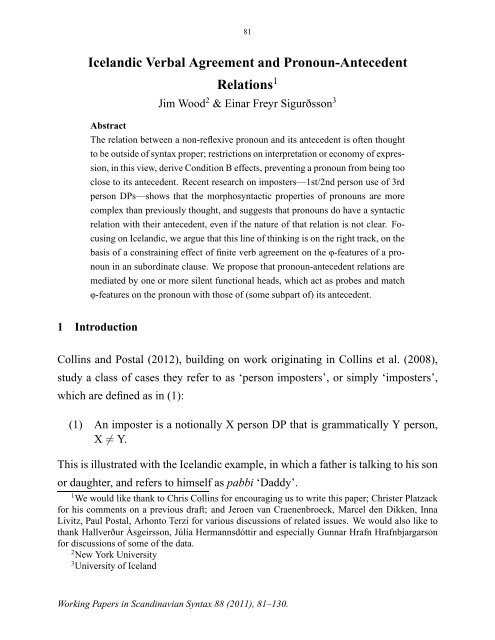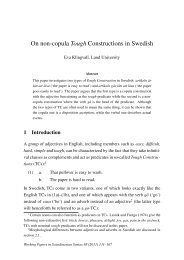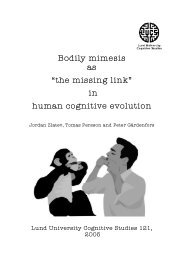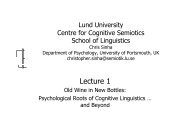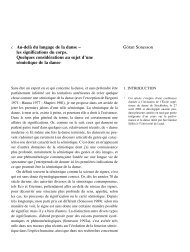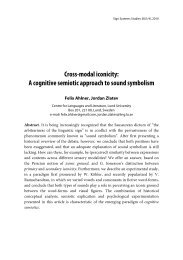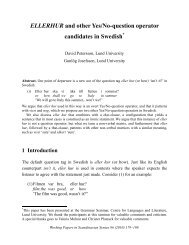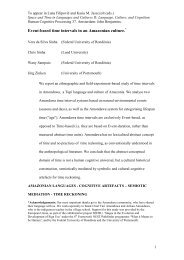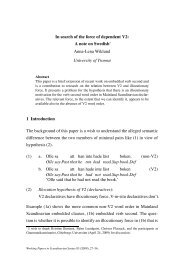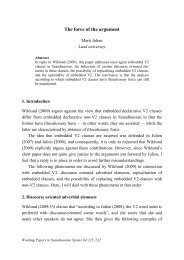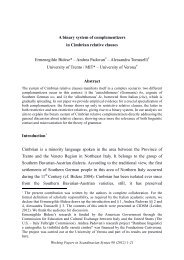Icelandic Verbal Agreement and Pronoun-Antecedent Relations
Icelandic Verbal Agreement and Pronoun-Antecedent Relations
Icelandic Verbal Agreement and Pronoun-Antecedent Relations
- No tags were found...
Create successful ePaper yourself
Turn your PDF publications into a flip-book with our unique Google optimized e-Paper software.
82(2) Svona svona, elskan, pabbi er hér.there there dear Daddy is.1/3SG here‘There there, dear, Daddy is here.’This is an example of a 1st person imposter. The DP pabbi ‘Daddy’ is notionally1st person (referring to the speaker), but grammatically 3rd person. (3) is an exampleof a 2nd person imposter which has come into use in the colloquial language.Here, the speaker is referring to his addressee using a 3rd person DP kallinn ‘theguy’ instead of the 2nd person pronoun þú ‘you’.(3) Hvað segir kallinn?what says.2/3SG guy.the‘How are you?’As we will show below, kallinn ‘the guy’ can also be a 1st person imposter. In thispaper, we will mostly focus on 1st person imposters.Collins <strong>and</strong> Postal (2012) show that the syntactic behavior of imposterspresents some interesting puzzles for our underst<strong>and</strong>ing of personhood <strong>and</strong> pronounantecedentrelations. As discussed further below, phenomena involving impostersstrongly suggest a linguistic, most likely syntactic relation between a pronoun <strong>and</strong>its antecedent. In this paper we will address a number of issues relating to <strong>Icel<strong>and</strong>ic</strong>imposters, with a focus on the effect of finite verb agreement on pronounantecedentrelations. We will propose that the relationship between a pronoun <strong>and</strong>its antecedent is mediated by an intermediate functional head.Before continuing, some terminological discussion is in order. Collins <strong>and</strong>Postal (2012) argue that imposter DPs are structurally complex, <strong>and</strong> contain a nullpronoun corresponding to the intended referent. For example, a 1st person imposterwould have a null 1st person pronoun. The visible DP is referred to as the‘secondary DP’, <strong>and</strong> the null pronoun is referred to as the ‘notional core’. Thesetwo DPs are argued to be embedded within a third DP, which is called the ‘shellDP’. This is illustrated below.
85talking here’ or sá sem hér stendur ‘the one who is st<strong>and</strong>ing here’. The followingis an attested example from a parliament discussion.(7) Þrír þingmenn úr þingflokki Vinstri hreyfingarinnar – grænsthree MPs from party Left movement – greenframboðs, hv. þm. Kolbrún Halldórsdóttir, hv. þm.c<strong>and</strong>idate, honorable MP Kolbrún Halldórsdóttir, honorable MPÞuríður Backman og [sá sem hér stendur], höfum lagt framÞuríður Backman <strong>and</strong> the.one who here st<strong>and</strong>s.3SG have.1PL laid forthþáltill. sem hljómar á þessa lund, með leyfi forseta.resolution which sounds on this way, with permission president‘Three MPs from the Left-Green Movement, the honorable MP KolbrúnHalldórsdóttir, the honorable MP Þuríður Backman, <strong>and</strong> the one whost<strong>and</strong>s here, have submitted a parliamentary resolution which soundslike this – with the permission of the president.’This example is an imposter par excellence. Notice that the verb inside the relativeclause is 3rd person singular, showing that the relative head has the features orproperties of a 3rd person DP. However, the overall DP refers to the speaker, <strong>and</strong>despite being 3rd singular, it is conjoined with another 3rd person DP <strong>and</strong> controls1st person agreement on the main clause verb.A fourth type of imposter appears to have arisen rather recently, <strong>and</strong> is commonin very informal speech among certain speakers, especially younger ones. Thefirst is kallinn, sometimes spelled kjellinn (reflecting pronunciation; IPA = [katl˚In]<strong>and</strong> [kjEtl˚In], respectively). It is formally a noun with a definite suffix. 7 The secondis gamli ‘old’, also spelled gjemli. It is formally a ‘weak’ adjective, marked asthough it were modifying a definite noun. The examples below come from Googlesearches <strong>and</strong> <strong>Icel<strong>and</strong>ic</strong> television. 87 The st<strong>and</strong>ard way of writing this is karlinn, though this is not how it is usually written. Karlinnmeans ‘the man / the old man’, which is pronounced either [kartl˚In], or the same way as kallinn(IPA = [katl˚In]) . To our knowledge, karlinn, when written this way or pronounced [kartl˚In], neverhas the imposter reading.8 The example in (8c) is spelled with rather than . This diacritic is basically redundant,since in <strong>Icel<strong>and</strong>ic</strong> <strong>and</strong> both correspond to IPA [jE].
86(8) a. en kjellinn ætlar samt að passa sig að vera ekkertbut guy.the intends.2/3SG still to look.after REFL to be notof mikið í þessutoo much in this‘But I am still going to be careful not to be too involved in this.’b. Fullt af monní á leiðinni. Og allir í vasann hjá kjellinum.full of money on way.the <strong>and</strong> all in pocket.the by guy.the.DAT‘Lots of money on the way. And all of it into my pocket.’(Næturvaktin, Ep. 10, 1:03)c. Nóg að gera hjá gjémla.enough to do by old.DAT‘I’ve got plenty to do.’A fifth type of imposter, yðar einlægur, is analogous to English yours truly,in form <strong>and</strong> meaning. It is similar in that like yours truly, it can be used to end aletter. The following example comes from a Google search.(9) Yðar einlæguryours trulyhefurundanfarnarpast.fewvikur verið að velta fyrirweeks been to roll beforehas.2/3SGsér...REFL.3‘Yours truly has for the past few weeks been wondering...’It is different from English in that the form of the possessive pronoun, yðar, isan archaic honorific form (similar to German Sie ‘you’) <strong>and</strong> not normally usedin colloquial speech except in certain fixed expressions. Note that this form alsooccurs in certain fixed camouflage forms, such as yðar hágöfgi ‘your majesty’ <strong>and</strong>yðar hátign ‘your highness’. 9 Another camouflage construction, þinn (lata) rass‘your (lazy) ass’, uses the modern pronoun þinn ‘your’.(10) Mættumeetklukkanclock9, ef þú getur dregið þinn lata rass fram úr rúminu.9, if you can drag your lazy ass out of bed.the9 A camouflage construction is distinct from an imposter in that the referent of the whole DP isovertly expressed. For example, yðar hágöfgi ‘your majesty’ is used to refer to the addressee (i.e.it is 2nd person), <strong>and</strong> yðar is a 2nd person pronoun. In contrast, yðar einlægur ‘yours truly’ is usedto refer to the speaker, so the 2nd person pronoun yðar is not the referent of the whole DP.
87‘Meet at 9 o’clock, if you can drag your lazy ass out of bed.’Certain relational expressions such as þinn auðmjúki þjónn ‘your humble servant’also have (1st person, non-camouflage) imposter uses.(11) Þinn auðmjúki þjónn bíður tilskipanar þinnar.your humble servant awaits.2/3SG comm<strong>and</strong> your‘Your humble servant awaits your comm<strong>and</strong>.’Like English <strong>and</strong> other languages, imposters can also be formed with demonstrativessuch as þessi ‘this’ plus a noun naming some kind of role or job title, as inþessi fréttamaður ‘this reporter’. The following is an example taken from Googleof an imposter use of þessi bloggari ‘this blogger’. 10(12) Hann fer tvímælalaustit.M goes undoubtedlyhefur farið á.has.2/3SG gone toá lista yfir bestu tónleika sem þessi bloggarion list over best concerts that this blogger‘It undoubtedly goes on the list of the best concerts that this blogger hasever gone to.’It is unclear whether plural imposters with demonstratives of this sort canbe formed. Speakers seem to vary in whether they accept imposter uses of þessirfréttamenn ‘these reporters’, in English as well as in <strong>Icel<strong>and</strong>ic</strong>. We will not pursuethis issue here. A further, similar case involves nouns like ‘author’. Translationsfor ‘the present authors’ (núver<strong>and</strong>i/viðstaddir höfundar) do not have imposterreadings in <strong>Icel<strong>and</strong>ic</strong>. However, imposters of the sort höfundar þessarar greinar‘(the) authors of this article’ (with genitive case on ‘this article’) are possible. An10 Strikingly, a singular demonstrative can occur without a noun <strong>and</strong> form an imposter. In thefollowing example in (i), reportedly heard by Júlía Hermannsdóttir (p.c.), a father is speaking to hisinfant child:(i)Kannski að þessi getiMaybe that this can.1/3.SG.SBJV‘Maybe this one (=I) can help you.’hjálpaðhelpþér.you
89There are a number of potentially interesting properties of this construction,including the fact that they control 3rd person agreement <strong>and</strong> apparantly only occurin the 1st <strong>and</strong> 2nd person. However, when conjoined, with another 3rd personDP, they can control 1st person agreement, as in the following example found onGoogle:(15) Minns og lögfræðingurinn tilvon<strong>and</strong>i erum búnir að veraMINNS <strong>and</strong> lawyer.the future are.1PL finished.M.PL to behúkkt á á þessum geggjaða leik.hooked on on this crazy game‘Me <strong>and</strong> my future lawyer have been hooked on this awesome game.’(16) Minns og Búbbó erum komnar í hóp sorglegra bloggara,MINNS <strong>and</strong> Búbbó are.1PL come.F.PL in group sad bloggers.GENhöngum hér heima, rífumst í druslum og bloggum um þá!hang.1PL here at.home fight.1PL in sluts <strong>and</strong> blog.1PL about them‘Me <strong>and</strong> Búbbó have joined the group of sad bloggers, hanging aroundhere at home, picking on sluts <strong>and</strong> blogging about them!’Note moreover that minns can control number <strong>and</strong> gender agreement on verbalparticiples, as shown in (15) with búnir ‘finished’ <strong>and</strong> (16) with komnar ‘come’.This happens even in the singular, where finite verb agreement is 3rd person.(17) En vildi bara láta vita að minns er komin heim.but wanted just let know that MINNS is.1/3SG come.SG.F home‘But just wanted to let it be known that I have come home.’There also seem to exist 1st <strong>and</strong> 2nd person plural forms, okkas <strong>and</strong> ykkas, respectively,apparently built on the stem of the genitive/possessive forms of the pronouns(okka-r/ykka-r) plus -s. These forms are less common, however, <strong>and</strong> not all speakershave heard of them. Examples of okkas ‘we’ can be found with 3rd personagreement in the singular <strong>and</strong> plural, as well as 1st person plural agreement. Wehave not conducted a full study of the agreement possibilities with these forms, butsuch a study would seem to be a worthwhile topic for future research.In the following section, we discuss previous work on imposters, in <strong>Icel<strong>and</strong>ic</strong>
90<strong>and</strong> other languages. Then, we focus on the agreement <strong>and</strong> pronominal/reflexiveantecedence properties of the following imposters: undirritaður ‘undersigned (sg)’,undirritaðir ‘undersigned (pl)’, undirritaður og X ‘the undersigned <strong>and</strong> X’, pabbi‘Daddy’, <strong>and</strong> mamma og pabbi ‘Mommy <strong>and</strong> Daddy’. We will discuss some otherimposters along the way, <strong>and</strong> then turn to a closer look at some specific propertiesof undirritaður ‘undersigned (sg)’.3 Previous workPrevious work on imposters has addressed a number of issues cross-linguistically,including some preliminary work on verbal agreement. Wood (2009) studies theinteraction of <strong>Icel<strong>and</strong>ic</strong> imposters with an optional pronoun (known as the ‘proprialarticle’) that occurs with certain DPs in the language (see SigurDsson 2006).This study also includes a first probe into <strong>Icel<strong>and</strong>ic</strong> verbal agreement with imposters,which is pursued in more detail here. Vázquez Rojas (2007) studies aformally indefinite imposter in Mexican Spanish, which, when alone, agrees in the3rd person with the verb, but when in coordinate phrases (CoPs), can trigger 1stperson plural agreement. Das (2011) discusses imposters in Bengali, a languagewhich is apparently quite strict in that 1st <strong>and</strong> 2nd person pronouns generally cannottake imposter antecedents. She proposes that this is related to the rich verbalagreement exhibited by Bengali, <strong>and</strong> provides some preliminary comparison withEnglish, Italian <strong>and</strong> Albanian. While we will show that the strictest form of Das’sproposal cannot be maintained, we think that her intuition is on the right track <strong>and</strong>is worth refining. We will show that verbal agreement does indeed play a surprisinglyimportant role in pronominal antecedence relations in <strong>Icel<strong>and</strong>ic</strong>. However,we will also show that the relevant facts are more complicated than her proposalwould suggest. First, different imposters behave differently with respect to verbalagreement in <strong>Icel<strong>and</strong>ic</strong>. Second, agreement effects can be shown, on the basis ofsyncretism <strong>and</strong> ECM contexts, to be only partially morphological. Third, in ad-
91dition to agreement, a number of other properties are involved, including whetherthe pronoun is subject or object <strong>and</strong> whether the mood of the clause is subjunctiveor indicative. For reflexives, the type of reflexive (inherent, natural or disjoint) isapparently relevant in some cases as well.Our primary goal in this paper is to refine our underst<strong>and</strong>ing of the roleof verbal agreement in pronoun/reflexive-antecedent relations. <strong>Icel<strong>and</strong>ic</strong> verbalagreement is particularly interesting because it is clearly quite ‘rich’. Many verbalparadigms have a distinct form for each person/number slot. Others have syncretismin the singular between 2nd <strong>and</strong> 3rd person or 1st <strong>and</strong> 3rd person. 13(18) sjá ‘see’ (present ind.)SG PL1st sé sjáum2nd sérð sjáið3rd sér sjáhafa ‘have’ (present ind.)SG PL1st hef höfum2nd hefur hafið3rd hefur hafavera ‘be’ (present ind.)SG PL1st er erum2nd ert eruð3rd er eruDespite having rich agreement morphology, <strong>Icel<strong>and</strong>ic</strong> is not a referential pro-droplanguage (see SigurDsson <strong>and</strong> Egerl<strong>and</strong> 2009 <strong>and</strong> SigurDsson 2010 for recent discussion).This property of <strong>Icel<strong>and</strong>ic</strong> constrains the space of plausible analyses forthe effects seen in this paper.However, in order to study the effect of imposters on verbal agreement, anumber of other issues must be addressed along the way. Work on imposters inthe past few years has revealed several cross-linguistic tendencies, despite (oftenvery fine-grained) differences among individual languages, dialects, <strong>and</strong> idiolects.Many of these tendencies are also evident in <strong>Icel<strong>and</strong>ic</strong>. First, an imposter coordinatedwith a 3rd person DP is more likely to show 1st person effects than anon-coordinated plural imposter, which in turn is more likely to show 1st personeffects than a singular imposter. By ‘more likely’ here, we are referring both tointraspeaker comparative judgments across constructions, as well as to variationacross languages. Second, imposters corresponding to participial forms such as‘the undersigned’ tend to be more likely to show 1st person effects than imposters13 1st <strong>and</strong> 3rd person are syncretic in the past tense <strong>and</strong> subjunctive.
92like ‘Daddy’. This has been shown most clearly in Cattaneo (2007, 2009) forBellinzonese (al sotuscrit), a Northern Italian Dialect, <strong>and</strong> similar facts have beendemonstrated in Servidio (2010) for Italian (il sottoscritto), in Soare (2010) forRomanian (subsemnatul), in Kallulli (2010) for Albanian (i nënshkruari), <strong>and</strong> willbe evident below in the <strong>Icel<strong>and</strong>ic</strong> data on undirritaður as well.4 <strong>Verbal</strong> agreementIn general, we will see that verbal agreement with imposters in <strong>Icel<strong>and</strong>ic</strong> exhibitsthe following cross-linguistic tendency: plural <strong>and</strong> coordinated impostersare ‘more 1st person’ than singular imposters, <strong>and</strong> among singular imposters, ‘theundersigned’ is ‘more 1st person’ than ‘Daddy’ or ‘this reporter’. To illustratethese points, consider first that singular imposters basically do not allow 1st personagreement.(19) a. (Hann) pabbi { hefur / *hef } sagt þér það.(he) Daddy { has.3SG / *1SG } told you that‘Daddy has told you that.’b. Undirritaður { hefur / *hef } ákveðiðundersigned.M.SG { has.3SG / *1SG } decided‘The undersigned (sg) has decided to quit.’aðtohætta.quitBy comparison, 1st person agreement on the plural undirritaðir ‘the undersigned(pl)’, while not perfect, is much better than on the singular undirritaður ‘the undersigned(sg)’.(20) a. Undirritaður { hefur / *hef } ákveðiðundersigned.M.SG { has.3SG / *1SG } decided‘The undersigned (sg) has decided to quit.’b. Undirritaðir {hafa / ?höfum } haldiðundersigned.M.PL {have.3PL / ?1PL } held‘The undersigned (pl) have claimed this.’aðtohætta.quitþessuthisfram.forth
93While the second author <strong>and</strong> several other speakers we have consulted find a differencebetween undirritaður ‘undersigned (sg)’ <strong>and</strong> undirritaðir ‘undersigned (pl)’,as indicated in (20) above, we should note that we do find attested examples ofundirritaður ‘undersigned (sg)’ with 1st person agreement on the web, such as thefollowing: 14(21) a. Undirritaður hef kynnt mér skilmála fyrirundersigned.M.SG have.1SG familiarized myself conditions forDælulykil Atlantsolíu.discount.key Atlantsolía‘The undersigned (sg) has familiarized myself with the conditionsfor the Atlantsolía discount key.’b. Undirritaðurhefveriðbeenráðgjafi fjölda fyrirtækjaconsultant many companiesundersigned.M.SG have.1SGog fjárfesta.<strong>and</strong> investors‘The undersigned (sg) has been a consultant of many companies <strong>and</strong>investors.’In (22), we provide some attested examples of undirritaðir/undirritaðar ‘undersigned(pl.m/f)’ taking 1st person plural agreement. 15(22) a. Undirritaðirerumaðtovinnaworkaðtolokaritgerðfinal.thesistil B.S gráðufor B.S. degreeundersigned.M.PL are.1PLí íþróttafræðum.in athletic.studies‘The undersigned (pl) are working on their final thesis for a B.S.degree in athletic studies.’14 (21a) was retrieved from https://secure.fib.is/daelulykill.php on9/21/2011. Notice that the reflexive in (21a) 1st person, consistant with the generalizationsdiscussed below. (21b) was retrieved from http://blog.eyjan.is/larahanna/2008/07/20/peningar-um-peninga-fra-peningum-til-hvers-2/#comment-15029on 9/21/2011.15 (22a) was retrieved from http://skemman.is/stream/get/1946/745/1956/2/Fylgiskjal.pdf on 9/14/2011; (22b) from http://idjur.blogcentral.is/blog/2010/10/11/ferdin-2010/ on 9/21/2011.
94b. Undirritaðar ætlum að taka það að okkur að versla íundersigned.F.PL intend.1PL to take it to ourselves to shop insameiginlega máltíð fyrir laugardagskvöldið og kaupa smájoint meal for Saturday.evening <strong>and</strong> buy littlesnakk og nammi.snack <strong>and</strong> c<strong>and</strong>y‘The undersigned (pl) plan on taking it upon ourselves to shop togetherfor Saturday evening’s meal <strong>and</strong> buy some snacks <strong>and</strong> c<strong>and</strong>y.’Despite the fact that both are attested, we will continue to take seriously the nativespeaker judgments indicating that there is a difference, leaving open the possibilitythat some speakers might freely accept both variants. Note that we have found noexamples of imposter pabbi ‘Daddy’ with first person singular agreement, which,if non-accidental, would further illustrate the point shown below that ‘undersigned’shows 1st person effects more commonly/easily than ‘Daddy’.When we turn to coordinated DPs (CoPs), we find that certain imposterstrigger 1st person agreement more easily than others. When undirritaður ‘undersigned(sg)’ is coordinated, either 1st or 3rd person agreement is possible. Whenpabbi ‘Daddy’ is coordinated, 1st person agreement is much less acceptable.(23) a. Undirritaður og Jón {hafa / höfum } haldið þessuundersigned.M.SG <strong>and</strong> John {have.3PL / 1PL } held thisfram.forth‘The undersigned <strong>and</strong> John have claimed this.’b. Mamma og pabbi {hafa / ??höfum } sagt þér þetta áður.Mamma og pabbi {have.3PL / ??1PL } told you this before‘Mommy <strong>and</strong> Daddy told you this before.’Not all speakers would agree with these judgments exactly. However, in eachcase—for speakers who get a contrast at all—1st person is clearly better in thecoordinated case than in the singular case, which is completely out. As far aswe know, no speakers have the opposite judgment, preferring agreement in thesingular case over the coordinated case.
95<strong>Agreement</strong> with CoPs containing a 2nd person pronoun show interestingvariation cross-linguistically. In <strong>Icel<strong>and</strong>ic</strong>, as originally discussed in Wood (2009),such agreement is always either 3rd person (for the majority of speakers) or 1stperson (for fewer speakers), but never 2nd person, as far as we know.(24) a. * Þú og pabbi ætlið að fara saman í vinnuna í dagyou <strong>and</strong> Daddy intend.2PL to go together to work todayb. % Þú og pabbi ætla að fara saman í vinnuna í dagyou <strong>and</strong> Daddy intend.3PL to go together to work todayc. % Þú og pabbi ætlum að fara saman í vinnuna í dagYou <strong>and</strong> Daddy intend.1PL to go together to work today‘You <strong>and</strong> Daddy are going to work together today.’Even for speakers who accept (24b) rather than (24c), the effect of even the ‘least1st person’ imposter pabbi ‘Daddy’ is evident the ungrammaticality of 2nd personagreement, which is what is found on the non-imposter reading. Given that verbalagreement is a syntactic process, this fact alone suggests that the interpretation ofa 3rd person DP as 1st person has its roots in a syntactic process. When 1st <strong>and</strong>2nd person imposters are coordinated, some speakers accept 1st person agreement,while most prefer 3rd person.(25) Pabbi og uppáhalds sonur hans {%ætlum / ætla } að fara samanDaddy <strong>and</strong> favorite son his {%intend.1PL / 3PL } to go togetherí vinnuna í dag.to work today‘Daddy <strong>and</strong> his favorite son are going to work together today.’5 Reflexive antecedenceAs has long been known, <strong>Icel<strong>and</strong>ic</strong> has a rather complicated reflexive system(Sigurjónsdóttir 1992). In the typology of Reul<strong>and</strong>’s (2011) monograph, <strong>Icel<strong>and</strong>ic</strong>is described as having the most complex system (a ‘four-way’ system), <strong>and</strong> is arguablyeven more complex than Reul<strong>and</strong> (2011) indicates. We will see below that
96reflexive/antecedence forms are sometimes sensitive to the type of reflexive construction.We are not in a position to offer an account as to why this is, but includeit for now as a control on the data. More research would be required to underst<strong>and</strong>exactly what the facts are with respect to a more sophisticated set of properties ofreflexive predicates. For now, we will focus our preliminary discussion on threetypes of reflexives: inherent reflexives, natural reflexives, <strong>and</strong> naturally disjointreflexives. Inherent reflexives include skemmta sér ‘enjoy oneself/have fun’ <strong>and</strong>skammast sín ‘be/feel ashamed of oneself’. They have the property that they canonly take a reflexive object (not a non-reflexive object), <strong>and</strong> a simplex reflexiveat that (i.e. without ‘self’). 16The simplex reflexive can be accusative (sig), dative(sér) or genitive (sín). Natural reflexives include auglýsa ‘advertise’ <strong>and</strong> raka‘shave’; these verbs ordinarily take a simplex reflexive, but can take a non-reflexiveDP object, <strong>and</strong> do allow a complex ‘self’ reflexive, if used with contrastive focus.Naturally disjoint reflexives such as elska ‘love’ do not normally allow a simplexreflexive, but rather require a complex ‘self’ reflexive. This is summarized below.(26) Simplex ‘Self’ Disjoint obj. ExamplesNaturally disjoint No Yes Yes elska ‘love’Natural reflexives Yes Focus Yes auglýsa ‘advertise’raka ‘shave’Inherent reflexives Yes No No skemmta ‘enjoy’,skammast ‘ashame’This does not do full justice to the complexity of the reflexive system in <strong>Icel<strong>and</strong>ic</strong><strong>and</strong> the areas of grammar where it is relevent, but it is sufficient for present purposes.See Reul<strong>and</strong> (2011) for recent theoretical discussion <strong>and</strong> Árnadóttir et al.(2011) for a number of further subtypes of reflexive constructions.As we will see in the examples below, verbal agreement plays a role in theacceptability of reflexive antecedence. This is perhaps a welcome <strong>and</strong> unsurprisingresult, given that a number of theories in recent years have proposed that thedependency between a reflexive <strong>and</strong> its antecedent is mediated by an agreement16 As discussed by Árnadóttir et al. (2011), skemmta also has a non-reflexive use meaning ‘entertain’,but the readings are distinct enough for present purposes.
98c. Þeir tölduthey believe{?okkur i+j /{?our / theirundirritaðan i ogundersigned.M.SG.ACC <strong>and</strong>} meira en alltsig i+jJón j elskaJohn loveannað.elsesjálfaself} more than everything‘They believed the undersigned <strong>and</strong> John to love themselves morethan anything else.’Since singular imposters do not easily take 1st person agreement, it might be expectedindependently of anything else that 1st person anaphors are not possiblein finite contexts. This is so, even when the verb in question is morphologicallysyncretic for 1st <strong>and</strong> 3rd person, as in the examples below. 18(29) a. Undirritaður i skammast {*mín i / sín i } fyrirundersigned.M.SG shame.1/2/3SG {*myself / himself } forummælin.comments.the‘The undersigned (sg) feels ashamed due to his comments.’b. Pabbi i skemmti {*mér i / sér i } vel í gær.Daddy enjoyed.1/3SG {*myself / himself } well yesterday‘Daddy enjoyed himself yesterday.’However, the asymmetry between singular <strong>and</strong> plural imposters goes further thanthis. Recall that when agreement is controlled for with an ECM predicate, theplural cases allow both 1st <strong>and</strong> 3rd person reflexives, though the latter are preferable.Even when agreement is controlled for with an ECM predicate, where thereis never any overt agreement, there is a clear contrast between the plural cases in(28) <strong>and</strong> the singular ones shown in (30) <strong>and</strong> (31) below.(30) a. Þeir töldu undirritaðan i skammast {*mín i /they believed undersigned.M.SG.ACC shame {*myself /sín i } fyrir ummælin.himself } for comments.the‘They believed the undersigned (sg) to feel ashamed for his comments.’18 As indicated, skammast ‘shame’ is in fact syncretic for all persons in the singular, though itdoes make person distinctions in the plural.
99b. Þeir sáu undirritaðan i auglýsa {??mig i / sig i }they saw undersigned.M.SG.ACC advertise {??myself / himself }í sjónvarpinu.in television.the‘They saw the undersigned (sg) advertise himself on TV.’c. Þeir töldu undirritaðan i elska sjálfan {*mig i / sig i }they believed undersigned.M.SG.ACC love self {*my / his }meira en allt annað.more than everything else‘They believed the undersigned (sg) to love himself more than anythingelse.’(31) a. Þeir sáu pabba i skemmta {*mér i / sér i } vel í gær.they saw Daddy enjoy {*myself / himself } well yestarday‘They saw Daddy enjoying himself yesterday.’b. Þeir sáu pabba i raka {*mig i / sig i } í gær.they saw Daddy shave {*myself / himself } yesterday‘They saw Daddy shaving himself yesterday.’c. Þeir töldu pabba i elska sjálfan {*mig i / sig i } meira enthey believed Daddy love self {*my / him } more thanallt annað.eveything else‘They believed Daddy to love himself more than anything else.’Just as morphological syncretism on the finite verb does not help singular impostersantecede 1st person reflexives, putting a singular imposter in a non-agreeingECM subject position does not help either. This singular/plural asymmetry cannot,then, be attributed directly to the independent asymmetry with morphologicalagreement. When imposter pabbi ‘Daddy’ is coordinated, the effect is somewherein between these two cases—while inherent reflexives exclude a 1st personanaphor, for natural reflexives <strong>and</strong> naturally disjoint predicates, 1st person is notas bad as the singular case, but worse than coordinated undirritaður.
100(32) a. Þeir sáu mömmu i og pabba j skemmta {*okkur i+j / sér i+j }they saw Mommy <strong>and</strong> Daddy enjoy {*ourselves / themselves }vel í gær.well yesterday‘They saw Mommy <strong>and</strong> Daddy enjoy themselves yesterday.’b. Lögreglan sá mömmu i og pabba j raka {??okkur i+j /sig i+j }police.the saw Mommy <strong>and</strong> Daddy shave {??ourselves/themselves }á ströndinni í gær.on beach.the yesterday‘The police saw Mommy <strong>and</strong> Daddy shaving themselves on the beachyesterday.’c. Þeir töldu mömmu i og pabba j elska sjálf {??okkur i+j / sig i+j }they believed Mommy <strong>and</strong> Daddy love self {??our / their }meira en allt annað.more than everything else‘They believed Mommy <strong>and</strong> Daddy to love themselves more than anythingelse.’Again, the difference between (31b-c) on the one h<strong>and</strong> <strong>and</strong> (32b-c) on the othercannot be attributed to morphological agreement.Undirritaðir ‘the undersigned (pl)’ is slightly worse with a 1st person reflexivethan undirritaður og Jón ‘the undersigned <strong>and</strong> John’, but not as bad as mammaog pabbi ‘Mommy <strong>and</strong> Daddy’.(33) a. Þeir tölduthey believedsín i+j } fyrirthemselves } forundirritaða i+j skammastundersigned.M.PL.ACC shameummælin.comments.the{?okkar i+j /{?ourselves /‘They believed the undersigned (pl) to feel ashamed of ourselves forour comments.’b. Þeir sáu undirritaða i+j auglýsathey saw undersigned.M.PL.ACC advertize} í{?okkur i+j /{?ourselves /sig i+j sjónvarpinu.themselves } in television.the‘They saw the undersigned (pl) advertize ourselves on TV.’
101c. Þeir töldu undirritaða i+j elska sjálfa {??okkur i+j /they believed undersigned.M.PL.ACC love self {??our /sig i+j } meira en allt annað.their } more than everything else‘They believed the undersigned (pl) to love ourselves more thananything else.’The data discussed so far are summarized in the table below.(34) Reflexive predicates1st inherent 1st natural 1st disjointDaddy * * *Undersigned * ?? *Mommy <strong>and</strong> Daddy * ?? ??Undersigned (plural) ? ? ??Undersigned <strong>and</strong> John ? (?) ?Here, we see that plurals with 1st person reflexives are generally better than singularswith 1st person reflexives. We also see some effects of the type of reflexives.Natural reflexives are slightly better than the others in the 1st person, <strong>and</strong> inherentreflexives are slightly better in the 1st person than disjoint reflexives are.Given the above, it might be suggested that mamma og pabbi ‘Mommy <strong>and</strong>Daddy’ does not show an asymmetry with respect to singular pabbi ‘Daddy’ <strong>and</strong>undirritaður ‘the undersigned (sg)’, since the reported difference between themis so slight (‘??’ versus ‘*’). However, turning to more complex constructionsreveals a much stronger asymmetry between singular pabbi ‘Daddy’ <strong>and</strong> coordinatedmamma og pabbi ‘Mommy <strong>and</strong> Daddy’. Like in English, a preposed purposeclause improves the 1st person reflexive in the plural even more, to the point where3rd person is actually quite odd, as illustrated in (35a). 19 Note, however, that 1st19 Control into purpose clauses can in general improve the 1st person reflexive with a pluralimposter, <strong>and</strong> is better than control into a complement clause.
102person is still quite bad here, as illustrated in (35b). 20(35) a. Til þess að læra að raka {okkur i+j / *sig i+j } betur, sagðifor it to learn to shave {ourselves / *themselves } better, toldJón frændi mömmu i og pabba j að fara á námskeið.John Uncle Mommy <strong>and</strong> Daddy to go to class‘In order to learn to shave better, Uncle John told Mommy <strong>and</strong>Daddy to take a class.’b. Til þess að læra að raka {??mig i / sig i } betur, sagðifor it to learn to shave {??myself / himself } better, toldmamma pabba i að fara á námskeið.Mommy Daddy to go to class‘In order to learn to shave better, Mommy told Daddy to take aclass.’Thus, even with the imposter use of pabbi ‘Daddy’, the coordinated case is ‘more1st person’ than the singular case. We thus see the following hierarchy of ‘1stperson-ness’:(i)(ii)Þeirtheylétu mömmu imade Mommy}og pabba j byggja sérstakt herbergi til að raka {?okkur i+j /<strong>and</strong> Daddy build special room for to shave {?ourselves /sig i+j í.themselves } in‘They made Mommy <strong>and</strong> Daddy build a special room to shave in.’Þeir telja mömmu i og pabba j vonast til að raka {*okkur i+j / sig i+j }they believe Mommy <strong>and</strong> Daddy hope for to shave {*ourselves / themselves }einhvern tímann.some time‘They believe Mommy <strong>and</strong> Daddy to hope to shave someday.’20 Note that we find homogeneity effects as well, so that there can be a 1st person reflexive in thepreposed clause <strong>and</strong> a 3rd person reflexive in the lower clause.(i)Til þess að læra að raka {okkur i+j / *sig i+j } betur, sagði Jón frændi mömmu ifor it to learn to shave {ourselves / *themselves } better told John Uncle Mommyog pabba j að hvíla sig i+j áður en námskeiðið byrjar.<strong>and</strong> Daddy to relax themselves before class.the begins‘In order to learn to shave better, Uncle John told Mommy <strong>and</strong> Daddy to relax before theclass begins.’Since this effect seems to be the same as in English, we do not discuss it further here.
103(36) Coordinated undersigned > plural undersigned > coordinated ‘Daddy’> singular undersigned > singular ‘Daddy’This combines the tendencies that CoPs are more 1st person than plurals, whichare more 1st person than singulars, as well as that ‘the undersigned’ is more 1stperson than ‘Daddy’.What we have shown in this section is that different imposters react differentlyto different reflexive types—even when overt morphology is controlled for byusing non-finite contexts. However, this does not mean that a syntactic Agree relationis not responsible. Most theories within the Minimalist Program assume thereis an Agree relation between a light verb <strong>and</strong> a direct object, <strong>and</strong> this dependencyis not necessarily reflected in overt morphology on verb. Nevertheless, Kratzer(2009) has shown that morphological syncretism of verbal agreement forms makesa difference in reflexive binding in German. We find that in <strong>Icel<strong>and</strong>ic</strong>, this does notmake a difference for reflexives taking imposter antecedents, as seen most clearlyin the singular cases. We also saw a number of constraints that cannot be attributeddirectly to verbal agreement, such as the difference between singulars from pluralsin terms of the availablity of an imposter-antecedent of a 1st person reflexive. Still,we see here that overt agreement morphology does make a difference in constrainingreflexive-antecedent relations. When agreement is unambiguously 1st person,the reflexive must be 1st person. When agreement is 3rd person, the reflexive mustbe 3rd person. 216 Pronominal antecedence6.1 Direct objectsMany theories of reflexive antecedence might welcome the result that verbal agreementcan make a difference in constraining the forms of reflexives, <strong>and</strong> that thiscan be ameliorated to some extant when agreement is controlled for. Most of them21 The effect is weaker when agreement is 3rd person, however.
104would probably be hard pressed to find an explanation for the strong singular/pluralasymmetry, let alone the differences between different imposters. Still, number isan important category in the verbal domain; it has been proposed that events areinherently plural, for example, <strong>and</strong> number certainly plays a role in reciprocal constructions.So let’s suppose that the reflexive facts above could be understood interms of theories relating to constraints on agreement, given a vP-internal dependencybetween the verb <strong>and</strong> its object. What is surprising, on this view, is that justas verbal agreement seems to make a difference in the acceptability of 1st personreflexives with imposter antecedents, so too does it make a difference with 1st personpronouns with imposter antecedents. To present a clear case, we illustrate withthe ‘most 1st person’ imposter, coordinated ‘undersigned’. 22(37) a. Undirritaður i og Jón j hafa áðurundersigned.M.SG <strong>and</strong> John have.3PL beforevilji bara móðga {okkur i+j / ?þá i+j }.want.SBJV just insult {us / ?them }sagt að yfirvöldsaid that authorities‘The undersigned <strong>and</strong> John have said before that the authorities justwant to insult us.’b. Undirritaður i og Jón j höfum áður sagt að yfirvöldundersigned.M.SG <strong>and</strong> John have.1PL before said that authoritiesvilji bara móðga {okkur i+j / *þá i+j }.want.SBJV just insult {us / *them }‘The undersigned <strong>and</strong> John have said before that the authorities justwant to insult us.’Here, the 3rd person pronoun is not perfect in either case. But whereas it is onlyslightly odd when the antecedent controls 3rd person agreement, it is much worseor completely out when the antecedent controls 1st person agreement. Note thatthe mood of the complement clause makes no difference in this case, as shown inthe following examples which are indicative rather than subjunctive.22 In the following examples, some verbs glossed as subjunctive are morphologically syncreticwith indicative forms (e.g. 1st/2nd plural forms); the glosses are based on syntactic distribution,<strong>and</strong> are in many cases morphologically distinct.
105(38) a. Undirritaður i og Jón j uppgötvuðu í fyrra aðundersigned.M.SG <strong>and</strong> John discovered.1PL last year thatstjórnin vill reka {okkur i+j / ?þá i+j }.management wants.IND fire {us / ?them }‘The undersigned <strong>and</strong> John discovered last year that managementwants to fire us.’b. Undirritaður i og Jón j uppgötvuðum í fyrra aðundersigned.M.SG <strong>and</strong> John discovered.1PL last year thatstjórnin vill reka {okkur i+j / *þá i+j }.management wants.IND fire {us / *them }‘The undersigned <strong>and</strong> John discovered last year that managementwants to fire us.’The same effect obtains when plural ‘undersigned’ takes 1st person agreement<strong>and</strong> antecedes a pronoun in the complement clause; the pronoun must be1st person, <strong>and</strong> 3rd person is unacceptable. The mood of the complement clausemakes no difference here either.(39) a. Undirritaðir i+j höfum áðurundersigned.M.PL have.1PL beforebara móðga {okkur i+j / *þá i+j }.just insult {us / *them }sagt að yfirvöld viljisaid that authorities want.SBJV‘The undersigned (pl) have said before that the authorities just wantto insult us.’b. Undirritaðir i+j uppgötvuðum í fyrra að stjórninundersigned.M.PL discovered.1PL last year that managementvill reka {okkur i+j / *þá i+j }.wants.IND fire {us / *them }‘The undersigned (pl) discovered last year that management wantsto fire us.’When plural ‘undersigned’ takes 3rd person agreement <strong>and</strong> antecedes a pronounin a complement clause, the 1st person pronoun is generally preferred <strong>and</strong> the 3rdperson pronoun is at least dispreferred, in some cases odd. The contrast is a bit
106stronger in the indicative than in the subjunctive. 23(40) a. Undirritaðir i+j hafa áðurundersigned.M.PL have.3PL beforebara móðga {okkur i+j / (?)þá i+j }.just insult {us / (?)them }sagt að yfirvöld viljisaid that authorities want.SBJV‘The undersigned (pl) have said before that the authorities just wantto insult us.’b. Undirritaðir i+j uppgötvuðu í fyrra að stjórninundersigned.M.PL discovered.3PL last year that managementvill reka {okkur i+j / ?þá i+j }.wants.IND fire {us / ?them }‘The undersigned (pl) discovered last year that management wantsto fire us.’With the imposter mamma og pabbi ‘Mommy <strong>and</strong> Daddy’, the situation is reversed.The same contrast is evident, but here in the subjunctive rather than theindicative.(41) a. Mamma i og pabbi j hafaMommy <strong>and</strong> Daddy have.3PLtrufla {okkur i+j / ?þau i+j }.disturb {us / ?them }aldreineversagt að þú megirsaid that you may.SBJV‘Mommy <strong>and</strong> Daddy never said that you were allowed to disturbus.’b. Mamma i og pabbi j uppgötvuðu í morgun að skrímsliðMommy <strong>and</strong> Daddy discovered.3PL this morning that monster.theætlar að borða {okkur i+j / þau i+j }.intends.IND to eat {us / them }‘Mommy <strong>and</strong> Daddy discovered this morning that the monster isplanning to eat us.’23 Like the classes of reflexives discussed in the previous section, we will not attempt in thispaper an explanation of the effect of mood on antecedence relations, but rather include this datato control for a potentially relevant grammatical property of the sentences we are looking at. Notethat the morphological expression of mood makes a difference in the acceptability of long-distancereflexives for many (but not all) speakers (SigurDsson 1986).
107The mood of the complement clause seems to make a difference in the singularas well. When the embedded clause is subjunctive, ‘the undersigned’ preferablyantecedes a 1st person object pronoun, more so than ‘Daddy’.(42) a. Undirritaður i hefur áðurundersigned.M.SG has.2/3SG beforemóðga { mig i / (?)hann i }.insult { me / (?)him }sagt að þeir vilji barasaid that they want.SBJV just‘The undersigned (sg) has said before that they just want to insultme.’b. Pabbi i hefur aldrei sagt að þú megir trufla { mig i /Daddy has.2/3SG never said that you may.SBJV disturb { me /hann i }.him }‘Daddy never said that you were allowed to disturb him.’When the embedded clause is indicative, 3rd person is preferred for both.(43) a. Undirritaður i uppgötvaði í fyrra að þeir viljaundersigned.M.SG discovered.1/3SG last year that they want.INDreka {?mig i / hann i }.fire {?me / him }‘The undersigned discovered last year that they want to fire me.’b. Pabbi i uppgötvaði í morgun að skrímsliðDaddy discovered.1/3SG this morning that monster.theætlar að borða { (?)mig i / hann i }.intends.IND to eat { (?)me / him }‘Daddy discovered this morning that the monster plans to eat me.’These results are summarized in the table below.
108(44) Object pronounsIndicative Subjunctive1st obj 3rd obj 1st obj 3rd objDaddy (3rd agr) (?) ̌ ̌ ̌Undersigned (3rd agr) ? ̌ ̌ (?)Mommy <strong>and</strong> Daddy (3rd agr) ̌ ̌ ̌ ?Undersigned (plural) (3rd agr) ̌ ? ̌ (?)Undersigned <strong>and</strong> John (3rd agr) ̌ ? ̌ ?Undersigned (plural) (1st agr) ̌ * ̌ *Undersigned <strong>and</strong> John (1st agr) ̌ * ̌ *What we see here is that whenever the agreement triggered in the superordinateclause is 1st person, the DP triggering that agreement cannot antecede a 3rd personobject pronoun. We also see a difference between singular <strong>and</strong> plural. For example,while undirritaður ‘undersigned (sg)’ makes a slightly odd antecedent of a 1stperson pronoun, 3rd person being preferred, plural <strong>and</strong> coordinated ‘undersigned’,even with 3rd person agreement, preferably antecede a 1st person pronoun.6.2 SubjectsSubject pronouns show a paradigm similar to object pronouns in some respects,but distinct in others. If the verbal agreement is 3rd person, either a 1st or 3rdperson subject pronoun is possible.(45) a. Undirritaður i og Jón j hafa áður sagt að { við i+jundersigned.M.SG <strong>and</strong> John have.3PL before said that { wemunum / þeir i+j muni } ekki styðja skattahækkanir.will.SBJV / they will.SBJV } not support tax.hikes‘The undersigned <strong>and</strong> John have said before that we will not supporttax hikes.’b. Undirritaður i ogundersigned.M.SG <strong>and</strong>erum eruare.IND//þeir i+jtheyare.INDJón j uppgötvuðu í fyrraJohn discovered.3PL last year} með krabbamein.} with cancerað {við i+jthat {we
109‘The undersigned <strong>and</strong> John discovered last year that we have cancer.’If the verbal agreement is 1st person, however, the 3rd person pronoun is unacceptable.(46) a. Undirritaður i og Jón j höfum áður sagt að { við i+jundersigned.M.SG <strong>and</strong> John have.1PL before said that { wemunum / *þeir i+j muni } ekki styðja skattahækkanir.will.SBJV / *they will.SBJV } not support tax.hikes‘The undersigned <strong>and</strong> John have said before that we will not supporttax hikes.’b. Undirritaður i og Jón j uppgötvuðum í fyrra að {við i+jundersigned.M.SG <strong>and</strong> John discovered.1PL last year that {weerum / *þeir i+j eru } með krabbamein.are.IND / *they are.IND } with cancer‘The undersigned <strong>and</strong> John discovered last year that we have cancer.’With undirritaðir ‘undersigned (pl)’ <strong>and</strong> 3rd person agreement, either a 1stor a 3rd person pronoun is possible.(47) a. Undirritaðir i+j hafa áðurundersigned.M.PL have.3PL beforeþeir i+j muni } ekki styðjasagt að {við i+j munumsaid that {we will.SBJVskattahækkanir.tax.hikesthey will.SBJV } not support‘The undersigned have said before that we/they will not support taxhikes.’b. Undirritaðir i+j uppgötvuðu í fyrra að {við i+j erum /undersigned.M.PL discovered.3PL last year that {we are.IND /þeir i+j eru } með krabbamein.they are.IND } with cancer‘The undersigned (pl) discovered last year that we have cancer.’When undirritaðir ‘undersigned (pl)’ occurs with 1st person agreement, the 3rdperson pronoun is unacceptable, <strong>and</strong> only a 1st person pronoun can take undirritaðir//
110as an antecedent.(48) a. Undirritaðir i+j höfum áður sagt að {við i+jundersigned.M.PL have.1PL before said that {we*þeir i+j muni} ekki styðja skattahækkanir.*they will.SBJV} not support tax.hikesmunumwill.SBJV‘The undersigned (pl) have said before that we/they will not supporttax hikes.’uppgötvuðum í fyrra að {við i+j erum /discovered.1PL last year that {we are.IND /*þeir i+j eru } með krabbamein.*they are.IND } with cancer‘The undersigned (pl) discovered last year that we have cancer.’b. Undirritaðir i+jundersigned.M.PLCoordinated mamma og pabbi ‘Mommy <strong>and</strong> Daddy’ behaves differently.To the extent that there is a contrast, it is the 1st person pronoun that is a bitmarked. The 3rd person pronoun is preferred. Notice that this cannot be tied toverbal agreement in these cases, since undirritaðir ‘the undersigned (pl)’ in theexample above <strong>and</strong> mamma og pabbi ‘Mommy <strong>and</strong> Daddy’ in the example beloware controlling 3rd person plural agreement.(49) a. Mamma i og pabbi j hafa aldrei sagt að {(?)við i+jMommy <strong>and</strong> Daddy have.3PL never said that {(?)weætlum / þau i+j ætli } að kaupa nammi h<strong>and</strong>a þér.intend.SBJV / they intend.SBJV } to buy c<strong>and</strong>y for you‘Mommy <strong>and</strong> Daddy never said that we planned on buying c<strong>and</strong>yfor you.’b. Mamma i og pabbi j uppgötvuðu í morgun að {(?)við i+jMommy <strong>and</strong> Daddy discovered.3PL this morning that {(?)weþurfum / þau i+j þurfa } ekki að vinna í dag.need.IND / they need.IND } not to work today‘Mommy <strong>and</strong> Daddy discovered this morning that we don’t have towork today.’Turning to singular imposters, there is again a contrast between ‘undersigned’<strong>and</strong> ‘Daddy’. For embedded subject pronouns, both prefer 3rd person.//
111However, the 1st person pronoun is considerably better for ‘the undersigned’ thanfor ‘Daddy’.(50) a. Undirritaður i hefur áðurundersigned.M.SG has.2/3SG beforemuni ekki styðjasagtsaidskattahækkanir.tax.hikesað {?ég i / hann i }that {?I / he }will.SBJV not support‘The undersigned (sg) has said before that he will not support taxhikes.’b. Pabbi i hefur aldrei sagt að {??ég i / hann i } ætli aðDaddy has.2/3SG never said that {??I / he } intends.SBJV tokaupa nammi h<strong>and</strong>a þér.buy c<strong>and</strong>y for you‘Daddy never said that he was going to buy c<strong>and</strong>y for you.’There is no apparent difference depending on the mood of the embedded clause.(51) a. Undirritaður i uppgötvaði í fyrra að {?ég i / hann i }undersigned.M.SG discovered.1/3SG last year that {?I / he }ermeð krabbamein.be.1/3SG.IND with cancer‘The undersigned (sg) discovered last year that he has cancer.’b. Pabbi i uppgötvaði í morgun að {??ég i / hann i }Daddy discovered.1/3SG this morning that {??I / he }þarfekki að vinna í dag.need.1/3SG.IND not to work today‘Daddy discovered this morning that he doesn’t need to work today.’We summarize the results in the table below, <strong>and</strong> repeat the object-pronoun tablefor convenience.
112(52) Subject pronounsIndicative Subjunctive1st sub 3rd sub 1st sub 3rd subDaddy (3rd agr) ?? ̌ ?? ̌Undersigned (3rd agr) ? ̌ ? ̌Mommy <strong>and</strong> Daddy (3rd agr) (?) ̌ (?) ̌Undersigned (plural) (3rd agr) ̌ ̌ ̌ ̌Undersigned <strong>and</strong> John (3rd agr) ̌ ̌ ̌ ̌Undersigned (plural) (1st agr) ̌ * ̌ *Undersigned <strong>and</strong> John (1st agr) ̌ * ̌ *(53) Object pronounsIndicative Subjunctive1st obj 3rd obj 1st obj 3rd objDaddy (3rd agr) (?) ̌ ̌ ̌Undersigned (3rd agr) ? ̌ ̌ (?)Mommy <strong>and</strong> Daddy (3rd agr) ̌ ̌ ̌ ?Undersigned (plural) (3rd agr) ̌ ? ̌ (?)Undersigned <strong>and</strong> John (3rd agr) ̌ ? ̌ ?Undersigned (plural) (1st agr) ̌ * ̌ *Undersigned <strong>and</strong> John (1st agr) ̌ * ̌ *Several tendencies can be gleaned from these results. We see that 3rd person pronounsare bad with antecedents controlling 1st person agreement, irrespective ofthe subject/object distinction, <strong>and</strong> irrespective of mood. 1st person pronouns arebetter as objects than subjects, <strong>and</strong> better with plurals than with singulars. 1st personis (slightly) better in the subjunctive than in the indicative. 3rd person is abit worse on objects than on subjects, <strong>and</strong> on plural ‘undersigned’. 3rd person isa bit worse in the subjunctive than in the indicative. We are not in a position toaccount for all of these facts, <strong>and</strong> it is in fact not clear how robust they are. Westate them here to facilitate cross-linguistic comparison <strong>and</strong> as a stepping stone tofuture work. What we will discuss below is the relationship between pronouns <strong>and</strong>their antecedents more generally, the singular/plural asymmetry, <strong>and</strong> the behaviorof ‘undersigned’.
1137 <strong>Pronoun</strong>-antecedent relations <strong>and</strong> agreementIn the early stages of the minimalist program, there was an attempt to relegatephenomena associated with Binding Theory (BT) to the LF interface. The ideawas that there are interpretive restrictions on different kinds of DPs. The bindingconditions proposed in Chomsky (1995:211), for example, were the following:(54) (For a DP α in local domain D...)A. If α is an anaphor, interpret it as coreferential with a c-comm<strong>and</strong>ing phrasein D.B. If α is a pronominal, interpret it as disjoint from every c-comm<strong>and</strong>ingphrase in D.C. If α is an r-expression, interpret it as disjoint from every c-comm<strong>and</strong>ingphrase.Imposter phenomena pose very serious challenges to this kind of binding theory.For one thing, this Condition B will clearly not suffice to rule out a sentence suchas (55).(55) ?* Undirritaður i ogundersigned.M.SG <strong>and</strong>muni ekki styðjaJón j höfum áðurJohn have.1PL beforeskattahækkanir].tax.hikessagt [ CP að þeir i+jsaid that theywill.SBJV not support‘The undersigned <strong>and</strong> John have said before that we will not support taxhikes.’Here the embedded 3rd person pronoun þeir ‘they’ could easily refer to the sameindividuals as those referred to by undirritaður og Jón ‘undersigned <strong>and</strong> John’; itneed only be interpreted as disjoint from every c-comm<strong>and</strong>ing phrase in the localdomain, which in this case is the embedded CP (bracketed above). Neither theinterpretation of the matrix imposter nor the verbal agreement would be expectedto have an effect.There are many other problems with this kind of binding theory, as emphasizedin Collins <strong>and</strong> Postal (2012). This has led to a number of proposals attempt-
114ing to derive BT phenomena from properties of the syntactic derivation (Kayne2002; Zwart 2002; Reul<strong>and</strong> 2006, 2011; Boeckx et al. 2007; Hicks 2008, 2009).Among these (<strong>and</strong> other) theories, some assume a syntactic relation between anon-reflexive pronoun <strong>and</strong> its antecedent, <strong>and</strong> others do not. Collins <strong>and</strong> Postal(2012) argue that a primitive relation ‘antecede’ encodes referential dependenciesamong linguistic objects, <strong>and</strong> that this relation will hold between a pronoun <strong>and</strong> itsantecedent. Kayne (2002) has proposed that movement underlies this dependency,such that the antecedent will form a constituent with the pronoun <strong>and</strong> move subsequentlyout of that constituent. SigurDsson (2010, 2011) has argued that pronounsundergo matching relations with functional heads in the left-perpiphery, <strong>and</strong> thatin subordinate cases, these functional heads relate to the antecedent. Note that inall of these accounts, the ‘antecedent’ of a pronoun is necessarily not always pronounced.At the very least, ‘context linkers’ in the left periphery of an utterance (oralternatively, unpronounced antecedent DPs) will be present to antecede ‘discoursefree’ pronouns <strong>and</strong> pronouns used deictically.Imposter phenomena strongly suggest that pronouns do enter into syntacticdependencies with antecedents, either directly or indirectly. This has been arguedextensively in Collins <strong>and</strong> Postal (2012), so we will not repeat all the argumentshere. We will, however, briefly present one argument in favor of this conclusionrelating to verbal agreement, the phenomenon of interest here. Consider the viewthat pronouns refer freely, perhaps constrained by ϕ-features which add presuppositionsthat the referent meets some criterion (such as being female/feminine, fora pronoun like she). Such a view would have to be constrained so as to keep anordinary 3rd person pronoun from including the speaker in situations such as thefollowing.(56) María: Hvað gerðist? ‘What happened?’Bjartur i : Jón sagði að þeir {∗i+j}/{k+l} væru heimskir.John said that they were stupid‘John said that they were stupid.’
115As indicated with the indices, the speaker, Bjartur, cannot in this dialogue be understoodas a member of the set of individuals referred to by the pronoun þeir‘they’. With a minor modification to the matrix clause, however, this is possible:(57) María: Hvað gerðist? ‘What happened?’Bjartur i : Jón sagði undirrituðum {i+j} að þeir {i+j}/{k+l} væruJohn said undersigned.PL.DAT that they wereheimskir.stupid‘John told the undersigned (pl) that they were stupid.’The presence of an imposter antecedent, then, makes it possible for a 3rd personpronoun to include the speaker. If pronouns were interpreted basically freely, thisdependency on an antecedent would be a mystery. For the sake of argument, wemight constrain the denotation of pronouns by invoking ‘definite descriptions’. Wemight say that a 3rd person pronoun can include the speaker if it can independentlyrefer to some description of an individual which happens to be the speaker. Theappearance of undirritaðir ‘undersigned (pl)’ might then make such a descriptionsalient enough that the pronoun can pick out this description, which happens topoint to the speaker.However, recall the effect of agreement on the embedded pronoun. Simplifyinggreatly, we have the following schema:(58) a. Imposter ... Agr-3 [ pronoun-1/3 ]b. Imposter ... Agr-1 [ pronoun-1/*3 ]Concentrating on the 3rd person pronoun, consider the contrast in (59), repeatedfrom above.
116(59) a. Undirritaðir i+j hafa áðurundersigned.M.PL have.3PL beforestyðja skattahækkanir.support tax.hikessagt að þeir i+jsaid that theymuniwillekkinot‘The undersigned (pl) have said before that they will not support taxhikes.’b. * Undirritaðir i+j höfum áður sagt að þeir i+j muni ekkiundersigned.M.PL have.1PL before said that they will notstyðja skattahækkanir.support tax.hikes‘The undersigned (pl) have said before that they will not support taxhikes.’According to the account under consideration, the pronoun in (59a) can includethe speaker because the matrix clause makes available/salient a description thatthe pronoun can refer to, <strong>and</strong> that description happens to pick out the speaker.However, (59b) clearly makes such a description available as well. We would beforced to say that a 3rd person pronoun can include the speaker iff the linguisticelement making the appropriate description available is 3rd person, has 3rd personϕ-features, shows 3rd person behavior, etc. But note that invoking ‘person’features is a linguistic notion, not a referential notion. That is, in saving the ideathat pronouns have no linguistic relation with their antecedent, we are forced to invokelinguistic properties of that very antecedent. This moves away from the veryintuition of the assumption that pronouns refer freely, modulo the presuppostionsinduced by the ϕ-features that they are comprised of. It asserts a relation betweena linguistic element, the pronoun, <strong>and</strong> another linguistic element, the antecedent,<strong>and</strong> constrains the former with reference to linguistic properties of the latter. Itwould be far beyond the scope of the present article to argue against every imaginableform of the assumption that pronouns do not have a syntactic relation withtheir antecedent. However, the basic form of the argument should be clear—thelinguistic properties of pronouns seem to depend on the linguistic properties oftheir antecedents, <strong>and</strong> this is expected if there is a syntactic relation between the
117two.We would like to propose that the relation between a pronoun embedded ina finite complement clause <strong>and</strong> its antecedent is not direct, but rather mediatedby a functional head. This functional head is in turn matched by the antecedent.The antecedent, if in a finite clause, matches the appropriate functional structure<strong>and</strong> triggers agreement. We will argue that the effect of verbal agreement is betterunderstood if an intermediate functional head is involved, as in (60a), than if apronoun enters into a relation with the antecedent DP directly, as in (60b).(60) a. [. . . T fin . . . DP antecedent . . . F 0 . . . [ . . . DP pronoun . . . ] ]b. [. . . T fin . . . DP antecedent . . . [ . . . DP pronoun . . . ] ]In addition to having the empirical advantages outlined below, the proposal in (60a)has the advantage that it has the potential to reconcile the position that pronounstake antecedents syntactically with the hypothesis that Transfer of syntactic structureto the interfaces takes place in chunks known as phases (Chomsky 2001, 2007,2008; Marantz 2007). As a pronoun gets further from its antecedent structurally,more intermediate F 0 s would be involved in mediating a relation between a pronoun<strong>and</strong> its antecedent. One possibility is that such heads are present in the leftperipheryof phases (e.g. vP <strong>and</strong> CP). We will not, however, be able to flesh outthe details of this here.An intermediate functional head F 0 would be employed as follows. F 0 entersinto an Agree relation with both the imposter <strong>and</strong> the embedded pronoun. Differentimposters have different structural properties which make their 1st person featuresmore or less visible. When F 0 <strong>and</strong> the imposter Agree, whatever features allow F 0to be a probe will interact with the structure of the imposter to determine whetherF 0 can get 1st person features. If it can, the embedded pronoun will match those 1stperson features. The imposter then enters into an Agree relation with, say, finiteT 0 . When T 0 <strong>and</strong> the imposter Agree, whatever features allow T 0 to be a probewill interact with the structure of the imposter to determine whether T 0 can get 1st
118person features. Since T 0 <strong>and</strong> F 0 are distinct heads, they can be sensitive to distinctproperties of the imposter; F 0 might be able to pick up 1st person features (yieldinga 1st person pronoun) while T 0 cannot. The asymmetry above can be accountedfor if F 0 is, informally speaking, a ‘better’ 1st person probe than T 0 ; whenever T 0is able to find a 1st person feature in an imposter DP, so will F 0 , but not vice-versa.To illustrate with a concrete example, suppose that F 0 probes for gender <strong>and</strong>number <strong>and</strong> T 0 probes for number. Now suppose that we assume a condition onϕ-Agree that when a ϕ bundle enters into a successful Agree relation with anotherϕ bundle, they share their entire ϕ-feature set, not just the features that were involvedin establishing the Agree relation (Béjar 2003; see also Myler 2011). Now,suppose that in the complex DP leading to undirritaður ‘undersigned (sg)’, thegender feature is inactive; this is independently plausible given that the gender ofundirritaður ‘undersigned (sg)’ is determined by the notional core, so that a femalespeaker would be able to use the feminine form undirrituð. If undirritaður ‘undersigned(sg)’ gets its gender feature through valuation, then it would be expectedto be inactive the way unvalued features normally are upon valuation. Given theseassumptions consider the following structure:(61) FPF 0 {NUM:, GEN:}DP {3,MASC,SG}undirritaður‘undersigned’DP. . . DP {1,MASC,SG}ég‘I’. . . CP...<strong>Pronoun</strong> {PN: ,NUM: ,GEN:} ...
119F 0 probes <strong>and</strong> enters into an Agree relation with both the imposter DP <strong>and</strong> thepronoun embedded in CP. 24 Since the gender feature on undirritaður ‘undersigned(sg)’ is inactive, it agrees with the 1st person pronoun <strong>and</strong> picks up its entire ϕbundle. These features are simultaneously shared with the pronoun. 25 When theDP moves <strong>and</strong> Agrees with T 0 , the latter probes only for a number feature. It thenAgrees with undirritaður ‘undersigned (sg)’ <strong>and</strong> picks up 3rd person features ofthe latter.(62) TPT 0 {NUM: }DP. . . FPDP {3,MASC,SG}undirritaður‘undersigned’. . . DP {1,MASC,SG}ég‘I’F 0 {1,MASC,SG}. . . CP...<strong>Pronoun</strong> {1,MASC,SG} ...This account is in need of immediate refinement, but before turning to that, considerwhat work the F 0 head does. By invoking two separate probes, their featurescan be relativized such that the same imposter DP can share different sets of featureswith different functional heads. However, it can still capture the asymmetry24 In this structure, we show F 0 c-comm<strong>and</strong>ing the antecedent DP, but this is not strictly necessary.In the system of Řezáč (2003), for example, F 0 could be lower than the antecedent, Agree with theembedded pronoun, <strong>and</strong> then probe upward to Agree with the antecedent. On upward probing, seealso Baker <strong>and</strong> Willie (2010) <strong>and</strong> references therein.25 There are a number of technical alternatives to the account presented here, <strong>and</strong> differencesamong them will ultimately make a difference. To remain consistent, it would be more accurateto assume that neither the silent core pronoun nor the pronoun embedded in CP have valued ϕfeatures at the point in the derivation described above. Rather, the Agree relation would lead to asharing a ϕ index, along the lines of Pesetsky <strong>and</strong> Torrego (2007), <strong>and</strong> both pronouns would havetheir features filled in when valued by Agreeing with 1st person features elsewhere, such as in theleft periphery as in SigurDsson (2010, 2011). Spelling this out would complicate the discussionneedlessly, however.
120above. In order to get 1st person agreement on T 0 , T 0 ’s number feature wouldhave to be able to successfully Agree with the pronominal core. As long as F 0 hasa number feature as well, F 0 will be able to pick up 1st person features wheneverT 0 will be able to. But since T 0 lacks a gender feature, it will not necessarily beable to do what F 0 does.As mentioned above, there are a few aspects of the account as presentedabove that are in need of refinement. First, within the imposter DP itself, if thegender feature on the secondary DP is inactive, reasoning that it has to be valuedby the notional core DP, then the number feature would also be inactive. If nothingmore were said, the above account would allow T 0 to probe the notional core aswell <strong>and</strong> Agree in 1st person.However, suppose that this is exactly what happens in the plural cases, leadingto 1st person plural agreement. Then the question is why this does not happenas easily with singulars. 26In fact, there are a number of phenomena crosslinguisticallyto suggest that plural features control agreement in a much moreaggressive way than singular features do (Den Dikken 2001; Nevins 2011; Myler2011). Nevins (2011) has recently proposed that ‘singular’ is actually the absenceof a privative [PLURAL] feature rather than the presence of a [SG] feature or a[−PLURAL] feature (though see Harbour (2011) for a different theory based onother facts). What is important here is that regardless of the correct theory of numberfeatures themselves, number agreement seems to involve plurals only, or atleast in a much more robust way. From this perspective, singular agreement is akind of ‘default’ agreement.Returning to the account above, the number feature of T 0 would not be ableto Agree in number with a singular core. However, a plural core would be ableto trigger agreement on T 0 , <strong>and</strong> pass on the full ϕ-feature set, leading to 1st personplural agreement. This accounts for the contrast between undirritaður ‘un-26 Recall that we do find attested cases of undirritaður ‘undersigned (sg)’, though native speakerstend to judge them as worse than the plural cases.
121dersigned (sg)’ <strong>and</strong> undirritaðir ‘undersigned (pl)’ with 1st person agreement, repeatedin (63) from (20) above.(63) a. Undirritaður { hefur / *hef } ákveðiðundersigned.M.SG { has.3SG / *1SG } decided‘The undersigned (sg) has decided to quit.’b. Undirritaðir {hafa / ?höfum } haldiðundersigned.M.PL {have.3PL / ?1PL } held‘The undersigned (pl) have claimed this.’aðtohætta.quitþessuthisfram.forthThis account predicts that if a language has imposters whose gender features arevalued by the notional core, like undirritaður, <strong>and</strong> also has finite verbs which agreein gender as well as person, such imposters should trigger verbal person agreementas well, perhaps more agressively with certain gender values than others. We donot know at the present time if this prediction is borne out. 27Another question involves person features, which we have left out of theprobes above for illustrative purposes. The presence <strong>and</strong> values of person featureswithin complex DPs no doubt plays a role in the variation we see across differentimposter types. At least T 0 (or the related functional complex in the T-domain)probes for person features, <strong>and</strong> possibly F 0 does as well. We have assumed thatthe secondary DP has 3rd person features, <strong>and</strong> that to access the 1st person featuresof the notional core, the outside probe has to be able to skip the interveningsecondary DP (<strong>and</strong>/or the shell DP), for example by probing for gender featureswhich are inactive on the secondary DP. However, most imposters do show some3rd person behavior, such as the ability to control 3rd person agreement or antecede3rd person pronouns. The positioning <strong>and</strong> role of person features on differentkinds of imposters might play a role in constraining this.By relativizing different features to probes, we have an account of why 1stperson agreement in the matrix clauses forces a 1st person pronoun in the embeddedclause, but 3rd person agreement does not necessarily force a 3rd person27 Thanks to Christer Platzack for raising this question.
122pronoun. We also have the beginnings of an underst<strong>and</strong>ing for why plurals are‘more 1st person’ than singulars. We do not yet have an account for several otherasymmetries, such as the mild effects of subjunctive versus indicative mood <strong>and</strong> thesubject/object pronoun asymmetry. The cross-linguistic facts are not very well understoodhere either, so we hope that future research will provide a clearer picture<strong>and</strong> allow for an underst<strong>and</strong>ing of how these areas interact with pronominal antecedencein a more robust way. For now, we hope to have shown that the relationbetween a pronoun <strong>and</strong> its antecedent is better understood as being mediated bya functional head than a direct dependency. But certainly, there is some syntacticrelationship between a pronoun <strong>and</strong> its antecedent, or else the effect of agreementin the superordinate clause would seem to be a complete mystery.8 UndersignedThe present analysis also has the potential to explain why ‘undersigned’ behavesdifferently from other imposters. The idea was already broached above, where wesuggested that the ability of the probe F 0 to agree with the notional core derivedfrom the fact that the gender feature on undirritaður ‘undersigned (sg)’ comesfrom the notional core. For such elements, the feature valuation assigning gender(<strong>and</strong> number) would make those features inactive, allowing outside probes toAgree with the notional core past the secondary DP. Given this, the difficulty of anoutside probe agreeing with the notional core in an imposter such as pabbi ‘Daddy’stems from the fact that the secondary DP—pabbi—has inherent gender features.Here, we offer the following tentative hypothesis:(64) The more features of a secondary DP that are valued by the notionalcore, the more likely the person features of the notional core are to bevisible to outside probes.An example which seems to support this comes from the formally indefinite MexicanSpanish imposter un servidor ‘a servant’, discussed by Vázquez Rojas (2007).
123(65a) <strong>and</strong> (65b) show that the notional core determines the choice between unservidor ‘a servant (masculine)’ <strong>and</strong> una servidora ‘a servant (feminine)’. (65a)shows that un(a) servidor(a) can antecede a 1st person pronoun. In (65b), where unservidor is not a subject <strong>and</strong> does not control agreement, it can antecede a 1st personreflexive in the infinitive. In (65c), un servidor is the subject <strong>and</strong> controls 3rdperson singular agreement, much like undirritaður ‘undersigned (sg)’ (<strong>and</strong> singularimposters in general). In (65d), una servidora is coordinated with another DP<strong>and</strong> the resulting CoP triggers 1st person plural agreement, much like undirritaðurog Jón ‘undersigned <strong>and</strong> John’.(65) Mexican Spanisha. Es una pena que una servidora, por razones ajenas a mi voluntad,is a shame that a servant.F for reasons allien to my will,no pueda asistir.not can attend.INF‘It is a shame that a servant, for reasons beyond my will, cannot attend.’b. Es la especialidad de un servidor, testificar por mi mismo enis the specialty of a servant.M testify.INF for my self inqué condiciones están esos lugares.which conditions are those places‘It is the specialty of a servant, to testify for myself in which conditionsthose places are.’c. Un servidor está intent<strong>and</strong>o engañarse a sí mismo.a servant be.3S trying fool.INF.REFL ACC him self.‘A servant is trying to fool himself.’d. El miércoles, Fern<strong>and</strong>o y una servidora acompañamosthe Wednesday, Fern<strong>and</strong>o <strong>and</strong> a servant.F accompanied.1PLa mi padre al hospital.ACC my father to.the hospital‘On Wednesday, Fern<strong>and</strong>o <strong>and</strong> a servant accompanied my father to thehospital.’These facts are only suggestive, <strong>and</strong> further research is required to know what thefull range of agreement/antecedence possibilities are for this imposter. (Vázquez Ro-
124jas (2007) was not specifically focusing on agreement.) However, the facts knownso far are intriguing—an imposter which shares with undirritaður ‘undersigned(sg)’ the property that gender is determined by the core behaves like it in severalrespects: agreement seems to matter for reflexive antecedence, <strong>and</strong> coordinationallows 1st person verb agreement.Undirritaður ‘undersigned (sg)’ <strong>and</strong> un(a) servidor(a) ‘a servant’, however,share another property: both are formally indefinite. Despite this, both can beshown to distribute like definites. 28In <strong>Icel<strong>and</strong>ic</strong>, indefinite participles are allowedin a low position in various expletive constructions, as exemplified in (66a).Undirritaður ‘undersigned (sg)’ is not possible in this position, as shown in (66b).(66) a. Það hafði víst verið vopnaður lögreglumaður íEXPL had apparently been armed.M.SG policeman inhúsinu.house.the‘There had apparently been an armed policeman in the house.’b. * ÞaðEXPLhafðihadveriðbeenundirritaðurundersigned.M.SGí húsinu.in house.theIt is possible, however, that the indefinite form of undirritaður is misleading.It does strongly suggest that there is not an understood definite head noun such asmaðurinn ‘the man.DEF’. If so, we would expect the weak form, undirritaði ratherthan undirritaður, as in undirritaði maðurinn ‘the undersigned man’. However,given the rarity of indefinite imposters cross-linguistically, <strong>and</strong> the definite behaviorof undirritaður ‘undersigned (sg)’, it would be odd to suppose that the headnoun is indefinite, as in undirritaður maður ‘an undersigned man’. However, anotherpossibility exists. In <strong>Icel<strong>and</strong>ic</strong>, the strong form of participles shows up notonly in the attributive position of indefinite nouns, but also in the predicative position,as illustrated for undirritaður ‘undersigned (sg)’ in the following example:28 See Vázquez Rojas (2007) for illustration of this claim for Mexican Spanish.
125(67) Þannig á neyt<strong>and</strong>inn rétt á að hætta við samninginn innan tíuthus has consumer.the right on to stop with contract.the within tendaga frá því hann er undirritaður.days from that it.M is undersigned.M.SG‘Thus, the consumer has the right to terminate the contract within tendays from when it is undersigned.’Thus, one possibility is that undirritaður ‘undersigned (sg)’ in its imposter use is areduced relative clause. Then, it can be collapsed with the complex imposters seenearlier in (7), partially repeated here.(68) . . . Þuríður Backman og [sá sem hér stendur ], höfum lagt. . . Þuríður Backman <strong>and</strong> [the.one who here st<strong>and</strong>s.3SG ] have.1PL putfram . . .forth . . .In sum, the present approach has the potential to underst<strong>and</strong> the different behaviorof different imposters on the basis of their grammatical properties. We haveseveral working hypotheses, <strong>and</strong> not enough cross-linguistic data to tease themapart fully. One possibility is that imposters with gender, number, or other featurescontrolled by the notional core rather than by inherent specification are morelikely to show 1st person effects. Another possibility is that formally indefinite,or perhaps predicative, imposters are more likely to show 1st person effects. 29 Athird possibility is that imposters built on relative clauses are more likely to show1st person effects than imposters built on other structures (such as appositives, asproposed in Collins <strong>and</strong> Postal (2012)). The present approach would make senseof the first possibility more straightforwardly than the other two, but more crosslinguistic<strong>and</strong> analytical work needs to be done before it can be determined whetherthis is on the right track.29 One might object that crosslinguistically, ‘undersigned’ actually is definite, accompanied bythe definite article. However, if ‘undersigned’ really is the predicate of a reduced relative clause, thearticle would plausibly be related to the relative clause rather ‘undersigned’ itself. There are manycases like this; consider English He made (*the) headway versus The headway he made. Note that<strong>Icel<strong>and</strong>ic</strong> uses a special demonstrative sá for these kinds of functions.
1269 ConclusionIn this paper, we have shown that verbal agreement can have a constraining effecton pronoun-antecedent relations. This is unexpected from the perspective oftheories which take pronouns to be basically freely interpreted (modulo ConditionB, however formulated), but is underst<strong>and</strong>able if there is a syntactic relation betweena pronoun <strong>and</strong> its antecedent. However, we have also shown, in at least twoways, that agreement is not the only constraining factor. First, while 1st personagreement controlled by an DP prevents that DP from anteceding a 3rd personpronoun, 3rd person agreement controlled by an DP does not necessarily preventthat DP from anteceding a 1st person pronoun. The ability to antecede a 1st personpronoun, then, cannot be contingent on agreement. Second, when agreementis controlled for with contexts where the antecedent DP is not in a position thatcontrols agreement, such as in the embedded subject position of ECM constructions,there are still constraints on antecedence. So while agreement is a factor inpronoun-antecedent relations, it is not the only factor.We have proposed that this can be understood if pronoun-antecedent relationsare mediated by a silent functional head. This also has the potential to shedlight on why the 1st person features of certain imposters are more accessible thanothers, assuming that probes can be relativized to different features. This idea isnot entirely novel. An intermediary has been proposed in other accounts assuminga syntactic relation between a pronoun <strong>and</strong> its antecedent. Kayne (2002), whoargues that the syntactic relation in question is a movement relation, argues thatthere must be an intermediate movement between the base generated position ofthe antecedent <strong>and</strong> its l<strong>and</strong>ing site. 30 In H. Sigurðsson’s work (e.g. 2010; 2011),pronouns match various intermediate functional heads, which in turn match contextlinkers (topic features, etc.) <strong>and</strong>/or antecedent DPs. We take the agreement30 This accounts for Condition B, if such a position is not available in very local contexts. Thestructure associated with the self morpheme of English reflexives is argued to provide such anintermediate l<strong>and</strong>ing site.
127facts to be further evidence in favor of one or more silent, intermediate positionsmediating between a pronoun <strong>and</strong> its antecedent.ReferencesÁrnadóttir, Hlíf, Thórhallur Eythórsson, <strong>and</strong> Einar Freyr SigurDsson. 2011. Thepassive of reflexive verbs in <strong>Icel<strong>and</strong>ic</strong>. Nordlyd 37:39–97.Baker, Mark, <strong>and</strong> Udo Willie Willie. 2010. <strong>Agreement</strong> in Ibibio: From Every Headto Every Head. Syntax 13:99–132.Béjar, Susana. 2003. Phi Syntax: A Theory of <strong>Agreement</strong>. Doctoral Dissertation,University of Toronto.Boeckx, Cedric, Norbert Hornstein, <strong>and</strong> Jairo Nunes. 2007. Overt copies in reflexive<strong>and</strong> control structures. University of Maryl<strong>and</strong> Working Papers in Linguistics15:1–46.Cattaneo, Andrea. 2007. Imposters <strong>and</strong> Subject Clitics: Four different types ofImposters in Bellinzonese Manuscript, New York University.Cattaneo, Andrea. 2009. Imposters <strong>and</strong> Pseudo-Imposters in Bellinzonese <strong>and</strong>English. Manuscript, New York University.Chomsky, Noam. 1995. The Minimalist Program. Malden, MA: MIT Press.Chomsky, Noam. 2001. Derivation by phase. In Ken hale: A life in language, ed.Michael Kenstowicz, 1–52. Cambridge, MA: MIT Press.Chomsky, Noam. 2007. Approaching UG from Below. In Interfaces + Recursion= Language? Chomsky’s Minimalism <strong>and</strong> the View from Syntax-Semantics, ed.Uli Sauerl<strong>and</strong> <strong>and</strong> Hans-Martin Gärtner, 1–29. New York: Mouton de Gruyter.Chomsky, Noam. 2008. On Phases. In Foundational Issues in Linguistic Theory:Essays in Honor of Jean-Roger Vergnaud, ed. Robert Freidin, Carlos P. Otero,<strong>and</strong> Maria Luisa Zubizarreta, 133–166. Cambridge, MA: MIT Press.Collins, Chris, Simanique Moody, <strong>and</strong> Paul Postal. 2008. An AAE CamouflageConstruction. Language 84:29–68.
128Collins, Chris, <strong>and</strong> Paul M. Postal. 2012. Imposters: A Study of Pronominal <strong>Agreement</strong>.Cambridge, MA: MIT Press.Das, Satarupa. 2011. Bengali imposters. In NYU Working Papers in Linguistics,ed. Jim Wood <strong>and</strong> Neil Myler, volume 3, 28–46. New York: NYU.Den Dikken, Marcel. 2001. ‘Pluringulars’, pronouns <strong>and</strong> quirky agreement. LinguisticReview 18:19–41.Harbour, Daniel. 2011. Paucity, abundance, <strong>and</strong> the theory of number. Manuscript,Queen Mary University.Heim, Irene. 2008. Features on bound pronouns. In Phi theory: Phi-featuresacross modules <strong>and</strong> interfaces, ed. Daniel Harbour, David Adger, <strong>and</strong> SusanaBéjar, 35–56. Oxford: Oxford University Press.Hicks, Glyn. 2008. Why the Binding Theory Doesn’t Apply at LF. Syntax 11:255–280.Hicks, Glyn. 2009. The Derivation of Anaphoric <strong>Relations</strong>. Philadelphia, PA: JohnBenjamins.Kallulli, Dalina. 2010. Albanian imposters. Manuscript, University of Vienna.Kayne, Richard. 2002. <strong>Pronoun</strong>s <strong>and</strong> their <strong>Antecedent</strong>s. In Derivation <strong>and</strong> Explanationin the Minimalist Program, ed. Samuel David Epstein <strong>and</strong> T. DanielSeely, 133–166. Oxford: Blackwell.Kratzer, Angelika. 2009. Making a pronoun: Fake indexicals as windows into theproperties of pronouns. Linguistic Inquiry 40:187–237.Marantz, Alec. 2007. Phases <strong>and</strong> Words. In Phases in the Theory of Grammar, ed.Sook-Hee Choe, Dong-Wee Yang, Yang-Soon Kim, Sung-Hun Kim, <strong>and</strong> AlecMarantz, 191–222. Soeul: Dong-In Publishing Co.Myler, Neil. 2011. Anomalous <strong>Agreement</strong> in Quechua. Manuscript, New YorkUniversity.Nevins, Andrew. 2011. Multiple Agree with Clitics: Person Complementarity vs.Omnivorous Number. Natural Language <strong>and</strong> Linguistic Theory 29.Pesetsky, David, <strong>and</strong> Esther Torrego. 2007. The syntax of valuation <strong>and</strong> the inter-
129pretability of features. In Phrasal <strong>and</strong> clausal architecture: Syntactic derivation<strong>and</strong> interpretation. In honor of Joseph E. Emonds, ed. V. Samiian S. Karimi <strong>and</strong>W. K. Wilkins, 262–294. Amsterdam: John Benjamins.Reul<strong>and</strong>, Eric. 2006. Agreeing to Bind. In Organizing Grammar: Linguistic Studiesin Honor of Henk van Riemsdijk, ed. H. Broekhuis, Norbert Corver, R. Huybregts,U. Kleinhenz, <strong>and</strong> J. Koster, 505–513. Berlin: Mouton de Gruyter.Reul<strong>and</strong>, Eric. 2011. Anaphora <strong>and</strong> Language Design. Cambridge, MA: MITPress.Servidio, Emilio. 2010. Italian imposters. Manuscript, University of Siena.SigurDsson, Halldór Ármann. 1986. Moods <strong>and</strong> (long distance) reflexives in <strong>Icel<strong>and</strong>ic</strong>.Working Papers in Sc<strong>and</strong>inavian Syntax 25:1–53.SigurDsson, Halldór Ármann. 2006. The <strong>Icel<strong>and</strong>ic</strong> Noun Phrase: Central Traits.Arkiv för nordisk filologi 121:193–236.SigurDsson, Halldór Ármann. 2010. On EPP Effects. Studia Linguistica 64:159–189.SigurDsson, Halldór Ármann. 2011. Conditions on Argument Drop. LinguisticInquiry 42:267–304.SigurDsson, Halldór Ármann, <strong>and</strong> Verner Egerl<strong>and</strong>. 2009. Impersonal null-subjectsin icel<strong>and</strong>ic <strong>and</strong> elsewhere. Studia Linguistica 63:158–185.Sigurjónsdóttir, SigríDur. 1992. Binding in <strong>Icel<strong>and</strong>ic</strong>: Evidence from languageacquisition. Doctoral Dissertation, University of California, Los Angelos.Soare, Gabi. 2010. Person imposters in Romanian. Manuscript, University ofGeneva.Vázquez Rojas, Violeta. 2007. Indefinite imposters Manuscript, New York University.Řezáč, Milan. 2003. The fine structure of cyclic agree. Syntax 6:156–182.Wood, Jim. 2009. <strong>Icel<strong>and</strong>ic</strong> imposters <strong>and</strong> the proprial article. In NYU WorkingPapers in Linguistics, ed. Patricia Irwin <strong>and</strong> Violeta Vázquez Rojas, volume 2.New York: NYU.
130Zwart, Jan-Wouter. 2002. Issues Relating to a Derivational Theory of Binding.In Derivation <strong>and</strong> Explanation in the Minimalist Program, ed. Samuel DavidEpstein <strong>and</strong> T. Daniel Seely, 269–304. Oxford: Blackwell.


